The iPhone 4 Redux: Analyzing Apple's iOS 4.0.1 Signal Fix & Antenna Issue
by Brian Klug & Anand Lal Shimpi on July 15, 2010 12:28 PM EST- Posted in
- Smartphones
- Apple
- iOS 4
- iPhone 4
- Mobile
In case you haven’t noticed, the iPhone 4’s antenna design has come under considerable scrutiny. In our iPhone 4 review, we investigated the iPhone 4 antenna and came to two conclusions. First, that iOS 4 was displaying signal bars in an overly optimistic manner, compressing the dynamic range of possible signal bars users can see. Second, we identified a worst case signal drop of around 24 dB when the iPhone 4 is cupped tightly in the left hand, covering the black strip and possibly detuning the antennas and adding additional attenuation from the presence of the hand.
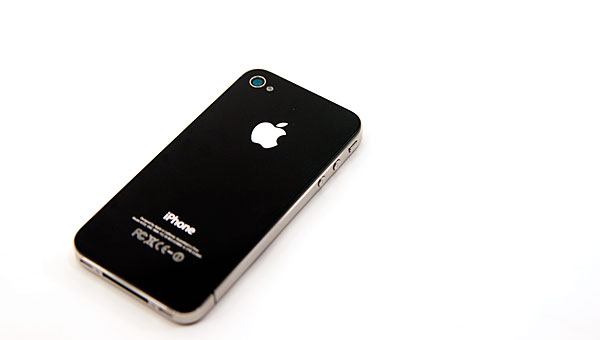
Since those initial measurements, we’ve been working tirelessly to both characterize the problem, fully understand the mechanisms behind it, and report on a number of possible solutions.
The Bars Have Changed
On July 2, Apple released a letter noting that the formula used in iOS 4.0 to calculate how many bars are presented for each signal strength is “totally wrong.” This mirrored our conclusions that the effects of the signal drop were exacerbated in part by the way the iPhone visualizes signal strength - the dynamic range is compressed so much that the 24 dB drop from cupping the phone without a case could make all the bars go away.
They went on to promise that in a future software update they would make bars 1, 2, and 3 taller, and make the bars more “accurate” by displaying 2 bars fewer in certain circumstances.
iOS 4.1 beta rolled around yesterday, and we immediately dove in to find out just how much the bar to signal strength mapping has changed. Update: iOS 4.0.1 final just came out this afternoon and we finished preliminary testing. The signal strength mapping algorithms are identical to the 4.1 beta. The findings in this article apply to 4.0.1 as well as the 4.1 beta.

After updating our devices to the iOS 4.1 beta (and 4.0.1) and making sure our little trick to show signal strength in dBm instead of bars still worked, we set off. Remember last time how I said I drove around town all day with iOS 4.0, testing the phone, and recording signal strength and how many bars were being shown? You guessed it - another update, another evening of driving around. Anand and I did quite our fair share of moving around to get a complete picture of what the new cutoffs are.
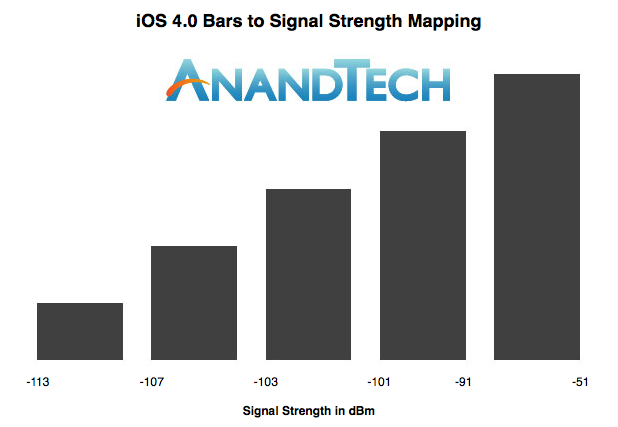
Old Bars
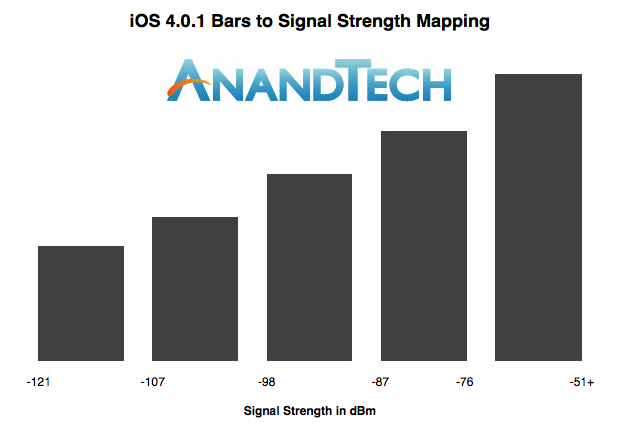
New Bars
The results are conclusive - Apple has dramatically changed the signal strength to signal bar mapping in iOS 4.0.1 and the iOS 4.1 beta, making the dynamic range not only much broader, but the range values for each bar much wider. The range of signals that correspond to bars three and four are the same width, and bar two is only slightly less.
The cutoff value for two bars to one bar remains the same, but every other value has increased. The result is that the worst case drop of 24 dBm no longer makes all the signal bars disappear, but rather two.
AnandTech reader Mike Escoffery, Director of Design and User Experience at Media Platforms, created his own diagram to help compare the old and new way of iOS signal strength reporting:
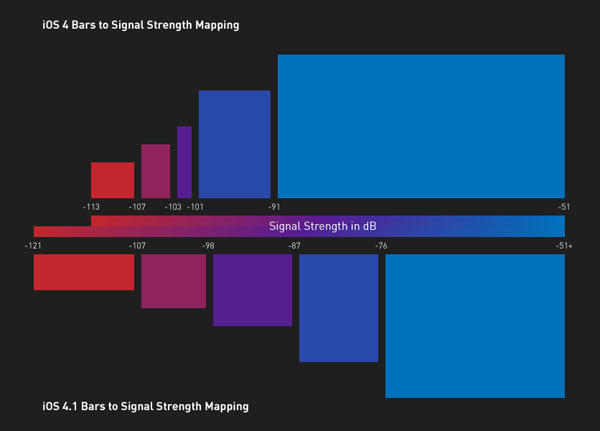
As you can see the old way (top) put far too much weight into the 5th bar of signal. Apple's new approach not only splits it up more reasonably between the 4th and 5th bar (still non-linearly keeping you in the 5th bar if possible) but also extends the range of the lower bars.
This change actually presented itself in our numeric signal strength reports - there’s more dynamic range in these numbers too. Previously, the absolute lowest value any iPhone would report was -113 dBm. With iOS 4.0.1/4.1, the value is now a shockingly low -121 dBm. In the iPhone 4 review, I talked a lot about how although the phone is prone to dropping signal from being held wrong, it was measurably more sensitive in weak signal areas. I was shocked that calls and data worked seemingly unfazed at -113 dBm. It seems as though this increased 8 dBm of range below -113 dBm was meant to show really how much more sensitive the radio stack is - it undeniably is more sensitive. Both Anand and I were able to hang onto calls all the way down at -121 dBm.
We’ve also included a comparison to how the latest version of Android displays signal bars from GSM or UMTS networks below. Thankfully, this didn’t require driving around town all day but rather inspecting the latest version of the Android source code from Google’s own repositories. Android uses an ASU value to compute signal strength, which isn’t anything more than a remapping of dBm to a sane value that’s a bit easier to interpret.
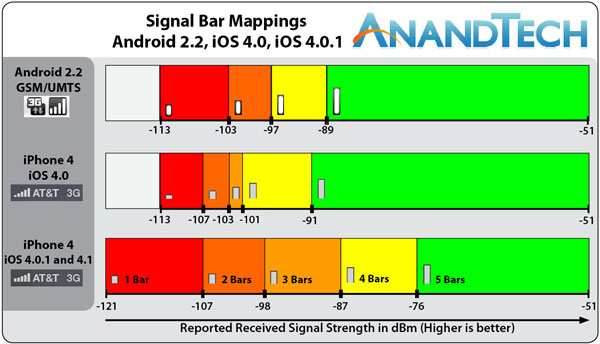
Apple’s mappings have gone from having probably the most compressed dynamic range among handset vendors to less compressed than Android.
While the software update obviously does not and cannot address the design of the antenna itself - or make the drop from holding the phone any less - it does change the way the issue is perceived among users. The result is that most iPhone users will see fewer bars disappear when they hold the iPhone 4 in a bare hand. The side effect is that the iPhone now displays fewer bars in most places, and users that haven’t been reporting signal in dBm will time see the - perhaps a bit shocking - reality of locations previously denoted as having excellent signal.
Interestingly enough, Apple has indeed changed the heights of bars 1, 2, and 3. They’re taller, and the result is that the relative heights are no longer linear, but rather a tad exponential looking. It’s a mind trick that Apple no doubt hopes will make the signal look better. If the bars are taller, they must denote stronger signal, right?
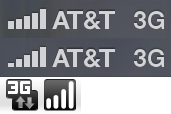
From top to bottom: iOS 4.1, iOS 4.0, Android 2.2
The reality is that Apple likely wants to deflect at least some of the initial backlash AT&T will face for reporting the signal bars without any concessions. Concessions that used to make coverage look better than it really is. Regardless of how tall the bars are, there are still going to be fewer of them virtually everywhere. Interestingly enough, while bars 1 and 2 are the most changed, their respective cutoffs are virtually unchanged.
While I was testing iOS 4.0.1, I told Anand that the signal reporting lie that started with the iPhone 3G had been removed entirely. That iOS 4.0.1 would potentially show the reality of AT&T’s coverage to iPhone users. With 4.0.1 users looking at signal bars will get a much more realistic view of how signal is changing.
We tested the iOS 4.1 beta on iPhone 3GSes as well, and found the mappings to be the same there as well.










146 Comments
View All Comments
stevessvt - Thursday, July 15, 2010 - link
All I did was post a link to this on apples forums and they took it off. Unbelievable.Snotling - Thursday, July 15, 2010 - link
unbelievable that they tolerate all the negative nonsense anybody posts anywhere and would prevent serious information from being found by their customers.bplewis24 - Thursday, July 15, 2010 - link
"I can’t stress enough that this issue impacts all users. The variability is in how strong of a signal you have to begin with. That’s the absolute only reason there’s debate in these discussions from phone to phone. At my desk I don’t get great reception on AT&T. With the iPhone 4 I’m usually at -96dBm. If I keep a tight grip on the phone or if I’m holding it to send text messages I can sometimes lose all signal entirely. This is a combination of poor reception at my house and the fact that the 4 loses more of its signal than other phones when held certain ways."Plain and simple, this above paragraph should have been in the 1st article. You and I both knew this back when the first article broke, but it was skirted around intentionally and every single person who denied that a problem existed referenced the Anandtech initial review. They will ignore this update/redux unless Apple comes out tomorrow and confesses to the design flaw.
Brandon
pr0nstar69 - Thursday, July 15, 2010 - link
You keep talking about the antenna as being the determining factor in terms of reception and holding a connection under poor signal conditions. I was wondering how you determined that this is really the case.The iPhone 4 also changed baseband hardware providers, from (IIRC) Infineon on the 3GS to Skyworks on the 4. I would imagine that they also play a role in the quality of signal maintained.
VahnTitrio - Thursday, July 15, 2010 - link
Working at 3M we have plenty of tape for all applications. 3M calls it's Kapton tape "Polyimide" and it does come as thin as 1/4". The number on the roll is 5413, and will probably run you about $20. It has tons of uses, we use it most often to secure thermocouples to electrical components.espiritiv - Monday, July 19, 2010 - link
http://www.thetapedepot.com/cart/index.php?option=...$7 bucks!
stevessvt - Thursday, July 15, 2010 - link
From iTunes now...Bare - Thursday, July 15, 2010 - link
Hey Brian and Anand,I just registered so that I could thank you for both your initial iPhone 4 review where you first detailed the antenna issue better than anyone else has to date, and also for this follow-up that discussed both the new signal bars in 4.1 and further discussed fixes for the real antenna issue. Your reviews are what sold me on this being an issue on all new iPhone 4 devices, and I couldn't agree more with your statements about how much impact this actually has on each iPhone 4 owner depends solely on the initial signal strength from AT&T. You have totally cleared away any of my confusion regarding this issue -- if only more people would read your blog!
Thanks,
Bare
boden - Thursday, July 15, 2010 - link
I suspect Y'all are going to have to run these tests again this weekend.slickr - Thursday, July 15, 2010 - link
Can you stop being so PRO Apple and so PRO Iphone 4.Its more than obvious that Iphone 4 is crap, its got broken antenna, broken USB port, broken Bluetooth and its costs 4x times that the amount it costs to develop it.
In simple words, its totally broken and overly expensive. So please stop defending Apple and truing to make them look good.
You Anandtech have a reputation to keep and this is the easiest way to loose it.
I've been following this website for more than 8 years and I hate it when I see hidden favoritism and/or hidden advertisement for companies.
You have banner space and that's where ads should start and END.